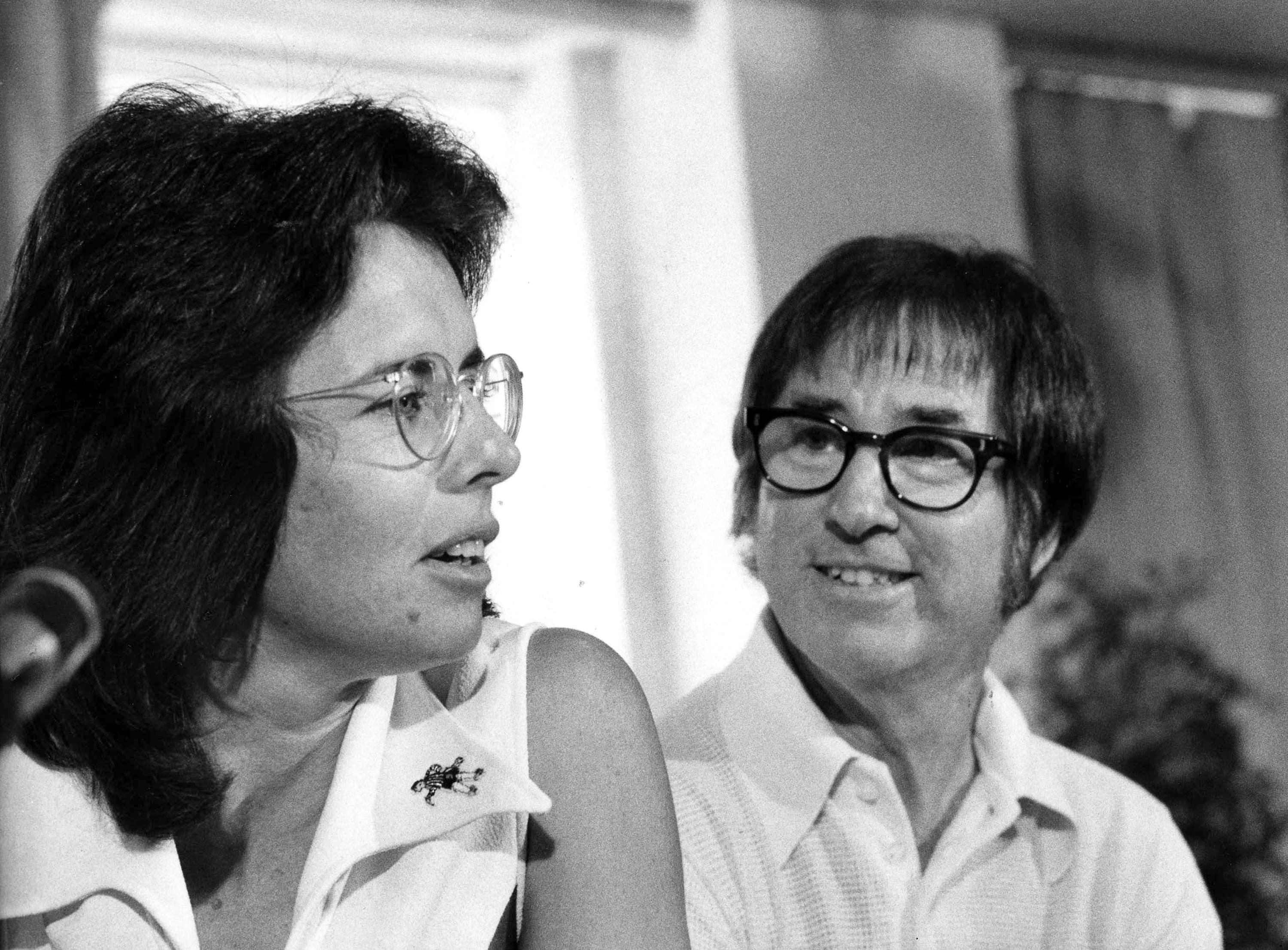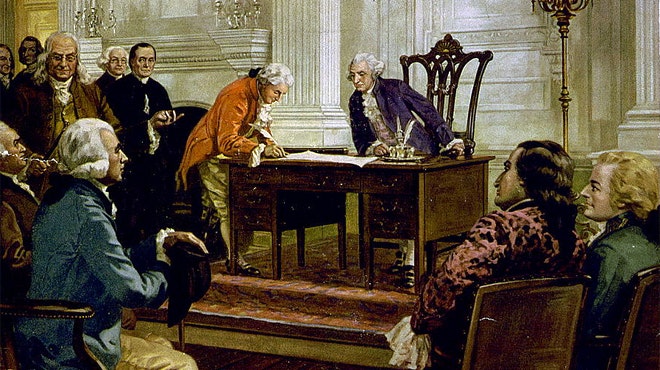Captain John Parker and 77 armed Americans stood on Lexington Common on what revolutionary Samuel Adams proclaimed “a glorious morning for America.”
It was April 19, 1775.
The “shot heard ‘round the world,” as Ralph Waldo Emerson later called it, was about to ignite the American Revolution and change world history forever.
Parker was 45 years old and riddled with tuberculosis. He roused his weakened body just after midnight, when the cry reached Lexington and echoed by a network of alarm riders through the Massachusetts countryside.
“The regulars are out!” Paul Revere himself warned the people of Lexington.
Now, at dawn, Parker’s small volunteer militia faced a terrifying sight: A force of 700 British regulars, highly trained soldiers, professional killers, well-armed agents of the most powerful empire on Earth.
The Lexington Minuteman Statue is superimposed against an American flag in a blue sky, on Lexington Common, Massachusetts. (H. Armstrong Roberts/ClassicStock/Getty Images)
The Redcoats were determined to squash a colonial rebellion that had been percolating in nearby Boston for nearly a decade.
The British hoped to seize a cache of colonial weapons and rebel leaders John Hancock and Sam Adams, who were in Lexington that very morning.
“I think [Parker and his men] were obviously scared,” Dan Davis, senior education manager for American Battlefield Trust, told Fox News Digital last year.
“I think they would have been angry and motivated, too, to protect their families and homes … They had a very large British force marching through their town.”
A Lexington Minuteman waits on Lexington Common, in the pre-dawn hour, April 18, 2022. The Battle of Lexington is commemorated on Patriots’ Day in Lexington, Massachusetts. The town pays tribute to those who died on the morning of April 19, 1775. (Joanne Rathe/The Boston Globe via Getty Images)
Parker had been elected captain of the local militia — the Lexington Training Band, as they called themselves — known as minutemen in popular lore.
They were farmers, blacksmiths, cordwainers and wagon makers.Many of the men were closely related — no more distant than cousins.
Most were devout Christians and extraordinarily well-read for common people.
“We were probably the most literate country in the world at the time,”Parker biographer Bill Poole, former president of the Lexington Historical Society, told Fox News Digital.
His statement is supported by many colonial scholars.
“Principally,” he added, “because we were great Bible readers.”
American troops were mocked as “Yankee psalm-singers” by their British foes, David McCullough noted in his book “1776,” an epic look at the dramatic year that followed.
American silversmith, engraver and Revolutionary patriot Paul Revere (1735-1818) rides to warn the people of Massachusetts that the British troops were advancing by boat, April 1775. He reached Lexington to warn minutemen there before being stopped by the British on the way to Concord. (Interim Archives/Getty Images)
The remarkable literacy of the colonists is considered a major reason why revolutionary ideals that toppled millennia of monarchial hierarchies took root so deeply among Americans in the 1700s.
Massachusetts was the center of the movement. The colony had a long simmering feud with Britain that reached its breaking point a year earlier with Parliament’s Intolerable Acts.
MEET THE AMERICAN WHO ROWED WASHINGTON ACROSS THE DELAWARE ON CHRISTMAS: SAILOR-SOLDIER JOHN GLOVER
Among other indignities, the acts closed the port of Boston, the source of the colony’s prosperity, and restricted the cherished tradition of town meeting in communities like Lexington. Colonists were outraged.
The moment of truth came on Lexington Common.
“Throw down your arms!Ye villains, ye rebels,” a British officer, most likely Major John Pitcairn, reportedly ordered the vastly outnumbered American volunteers.
Parker and his men defied the order.
“Stand your ground, do not fire unless fired upon,” Parker told his men. “If they mean to have a war, let it begin here.”
‘We trust in God’
Captain John Parker was born in Lexington on July 13, 1729, to Lt. Josiah and Anna (Stone) Parker.
Some of his ancestors had arrived in the Massachusetts Bay Colony as early as 1635, giving the Parker family roots as deep as any other in the future United States.
British soldiers fire upon members of the local militia company during the annual re-enactment of the Battle of Lexington on Lexington Common on Monday, April 15, 2019, in Lexington, Massachusetts. (Nicolaus Czarnecki/MediaNews Group/Boston Herald via Getty Images)
“A stout, large-framed man of medium height,” Poole writes in his biography of Parker.
Captain Parker is often described as a mechanic. He was, in essence, a woodworker — making spinning wheels, press screws and compass boxes.
ON THIS DAY IN HISTORY, DEC. 16, 1773, BRAZEN BOSTON TEA PARTY PROTEST ESCALATES AMERICAN REBELLION
He earned his military training in the French and Indian War (1756-63), though several experts note there is no documented evidence of his service, just oral history and circumstantial evidence.
He reportedly trained with Rogers’ Rangers. It was a group of New Hampshire soldiers instructed in irregular warfare — guerilla warfare. United States special forces trace their roots to Rogers’ Rangers and its “28 rules of ranging today.”
Those tactics proved critical to Parker’s leadership throughout the day.
A couple stop to pose next to a giant American flag hung on the side of Carey Memorial Library after watching the reenactment of the Battle of Lexington Green, a brief yet important marker of the American Revolution told and celebrated for 248 years. The Battle of Lexington is commemorated on Patriots’ Day, April 17, 2023, in Lexington, Massachusetts. The town pays tribute to those who died on Lexington Common on April 19, 1775. (Joanne Rathe/The Boston Globe via Getty Images)
The members of the Lexington Training Band were citizen-soldiers, bound not by military professionalism but by faith and a vow to each other.
It read: “We trust in God that, should the state of our affairs require it, we shall be ready to sacrifice our estates and everything dear in life, yea and life itself, in support of the common cause.”
It didn’t take a great military mind to understand that the volunteer militia, outnumbered nearly 10 to 1, was no match for the firepower of the British Empire arrayed before them.
Parker’s only hope was to avoid a fight, delay the Redcoats long enough to allow more minutemen to gather and confront the British force somewhere later and in a more advantageous position.
The first shots of the American Revolution were fired in Lexington, Massachusetts, on April 19, 1775. Print shows line of minutemen being fired upon by British troops. Engraving, circa 1903. Virginia orator Patrick Henry had called upon his colonists to raise a militia only four weeks earlier, famously demanding, “Give me liberty, or give me death!” (VCG Wilson/Corbis via Getty Images)
Fate had other plans. The shot that followed on Lexington Common, that ignited the American Revolution, remains a mystery to history.
The firefight quickly became a rout.
ON THIS DAY IN HISTORY, SEPTEMBER 6, 1757, MARQUIS DE LAFAYETTE IS BORN, HERO OF TWO REVOLUTIONS
“The British light infantry fired, ‘made a huzza,’ and ran furiously toward the retiring militia,” Alexander R. Cain writes in his history of the encounter, “We Stood Our Ground.”
Cain is also a member of the Lexington Minute Men, a group of historians and volunteers who keep alive the legacy of Parker and his men.
The Americans returned fire, but were overwhelmed and scattered.
When the smoke cleared, more than a dozen Americans lay dead or wounded. Nearly one-third of the 77 men who stood on Lexington Common that morning would be killed (11 of them) or were wounded by the end of the day.
Jonas Parker, the captain’s cousin, gave his life gruesomely on Lexington Common.
Lexington Minuteman Jonas Parker was shot, then killed by bayonet after vowing never to run from the British. A re-enactor lies dead after being bayonetted by one of His Majesty’s Regulars, one of the first casualties of the Battle of Lexington Green. The Battle of Lexington is commemorated on Patriots’ Day; the town pays tribute to those who died on April 19, 1775. (Joanne Rathe/The Boston Globe via Getty Images)
Parkerwas “standing … with his [musket] balls andflints in his hat onthe ground between his feet,” according to an account by fellow Lexington militiamenEbenezer Munroe.
Parker bravely declared “he would never run,” Munroe said.
Jonas Parker, he said, “was shot down atthesecond fire … I saw him struggling on the ground, attempting to loadhis gun … as he lay on the ground they (ran) him through with the bayonet.”
The slaughter of citizen-soldiers took place in front of the entire village.
MEET THE AMERICAN WHO FOUGHT AND BLED AT THE ALAMO BUT LIVED TO TELL ITS HEROIC TALE: SLAVE JOE
“As the regulars left the onslaught behind them, wives, children and the spectators emerged from hiding and made their way onto the common,” writes Cain.
“Many were overcome with emotion and grief at the sight of husbands, sons, brothers, cousins and neighbors lying dead or wounded on the field.”
Parker’s revenge
The British, with only a few of their men wounded, marched past the carnage and made their way toward Concord, seven miles to the west. But Parker’s delaying tactic worked.
Street signs in Lexington, Massachusetts, bear an emblem today that pays homage to Captain John Parker and the town militia, 77 men who stood up 700 British Redcoats on April 19, 1775, and fought the first battle of the American Revolution. “What a glorious morning for America.” (Kerry J. Byrne/Fox News Digital)
As the residents of Lexington tended to the wounded on the common, “over 200 men from Woburn’s militia and minuteman companies arrived in Lexington,” according to Cain.
“Disturbed at what they saw, the men halted and assisted the Lexington residents in treating the wounded and carrying the dead into the meetinghouse. Afterward, the Woburn men reassembled and resumed their march toward Concord.”
The 200 Woburn men were just the tip of the spear. Thousands more minutemen began to arrive from communities from all across Massachusetts.
The armed American citizens turned back the British soldiers in Concord and began chasing the troops back to Boston, picking off Redcoats along the way.
Boston Tea Party, Dec. 26, 1773. Inhabitants of Boston, Massachusetts, dressed as American Indians, threw tea from vessels in the harbor into the water as a protest against British taxation: “No taxation without representation.” Late 19th century wood engraving. (Photo12/Universal Images Group via Getty Images)
“Almost 2,000 militiamen … had descended to the area, and more were constantly arriving,” notes History.com.
Parker miraculously gathered his troops after the shock the men witnessed in the morning. They lay in waiting to ambush the British as they fled back to Boston.
“Some wore bandages stiffened from the blood of wounds they had suffered in the morning, and they were anxious to revenge themselves and their dead neighbors,” reports American Battlefield Trust.
The King’s Regulars shoot one last round on Lexington Common during the annual Patriots’ Day reenactment of the Battle of Lexington on Apr. 17, 2017. (Joanne Rathe/The Boston Globe via Getty Images)
They shot and killed an unknown number of British. The day ended in an incredible victory for America’s citizen soldiers.
The British by the end of the day suffered about 300 killed and wounded, to fewer than 100 for the Americans. They retreated to Boston.
Thousands of American militiamen laid siege to the British in Boston for nearly a year before the Redcoats finally fled on March 17, 1776. Massachusetts had won its rebellion against the British Empire while the American Revolution moved to other colonies.
“The site of Parker’s Revenge is the first of many fields where brave American soldiers turned defeat into victory,” writes American Battlefield Trust.
Patriots’ Day
John Parker succumbed to the tuberculosis that plagued him on Lexington Common on Sept. 17, 1775. He was only 46 years old.
His heroics gave rise to the Declaration of Independence the following year — and to a brave and daring new nation, the United States of America.
James Lee is the captain commanding the Lexington Minutemen, a group of re-enactors, patriots and American history enthusiasts. By company tradition, he portrays Capt. John Parker in the annual re-enactment of the “shot heard ’round the world,” which occurred on Lexington Common on April 19, 1775. (Michael Duncan Smith)
He never saw either.
No portrait of Parker exists. But his image lives on in American lore as the inspiration for the famous Minuteman Statueon Lexington Common; and in the nation’s faith of an armed citizenry as a bulwark against tyranny, encoded in the Second Amendment.
His legacy also survives in the United States Army Reserve — inspired by his selfless example of citizen-soldier rushing to the aid of their nation in need.
ARIZONA IS SITE OF NEW KIRK CAMERON, SHERIFF MARK LAMB LIBRARY BOOK EVENT: ‘FIGHT ON OUR HANDS’
The U.S. Army Reserve motto, “Twice the Citizen,” pays deference to the stand of Parker and the 77 that morning, while its official logo, a man in colonial headgear, is known as The John Parker.
The Lexington Minuteman Statue superimposed against an American flag in a blue sky, Lexington Common, Massachusetts. James Lee (at right) portrays Capt. John Parker during the annual reenactment on Lexington Common. (Getty Images and Michael Duncan Smith)
Sprawling and serpentine Minute Man National Park traces the long route of the “glorious day” in American history. Recent research has uncovered details of the site of Parker’s Revenge.
CLICK HERE TO SIGN UP FOR OUR LIFESTYLE NEWSLETTER
The stand of Parker’s 77, and the larger Battles of Lexington and Concord, are celebrated each year as Patriots’ Day, statewide holidays in Massachusetts and Maine, on the Monday closest to April 19.
The festivities begin at dawn with the reenactment of the Battles of Lexington and Concord; and celebrations occur in other communities as well, especially those who sent minutemen to fight the British that morning.
The giant American flag was unfurled over the Green Monster during the national anthem. The Boston Red Sox hosted the Minnesota Twins in the annual Patriots’ Day morning MLB baseball game at Fenway Park in Boston on April 18, 2022. (Jim Davis/The Boston Globe via Getty Images)
Lexington has reenacted the stand of its 77 men every year since 1791.
The Boston Red Sox play a home game at Fenway Park every Patriots’ Day at 11 a.m. It is the only morning game on the Major League Baseball calendar each year.
The streets of Boston and other Bay State communities erupt with parties and parades on Patriots’ Day as the Boston Marathon winds its way from western suburbs into downtown Boston.
It is one of the most eagerly anticipated days of the year in Massachusetts, among other things marking the arrival of spring.
Left, Minuteman monument in Lexington, Massachusetts. Center, re-enactor James Lee, captain commanding the Lexington Minutemen, portraying Capt. John Parker. Right, re-enactor portraying British redcoat. (Kerry J. Byrne/Fox News Digital; Michael Duncan Smith; Joanne Rathe/The Boston Globe via Getty Images)
Few Patriots’ Day celebrants today know the patriot who inspired the festivities.
“Captain Parker stood in defiance of a very powerful military power, the most powerful nation on Earth,” said Poole, the Lexington historian.
The Minuteman Statue in Lexington, Massachusetts, is meant to depict Captain John Parker, who led the outnumbered Lexington militia against the British regulars on April 19, 1775. The ensuing skirmish, the “shot heard ’round the world,” ignited the American Revolution. (Kerry J. Byrne/Fox News Digital)
“He stood for the rights of the community and the rights of the individual. He stood as a sick and weakened but powerful man for the rights of all Americans and, as such, should be held as a hero.”
CLICK HERE TO GET THE FOX NEWS APP
To read more stories in this unique “Meet the American Who…” series from Fox News Digital, click here.
For more Lifestyle articles, visit www.foxnews.com/lifestyle.
Kerry J. Byrne is a lifestyle reporter with Fox News Digital.




